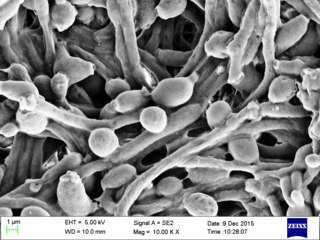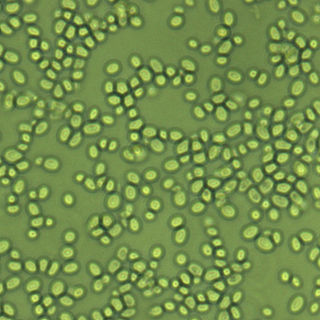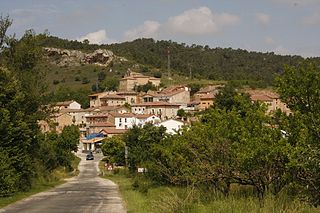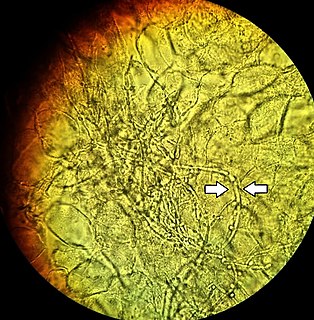
Candidiasis is a fungal infection due to any type of Candida. When it affects the mouth, in some countries it is commonly called thrush. Signs and symptoms include white patches on the tongue or other areas of the mouth and throat. Other symptoms may include soreness and problems swallowing. When it affects the vagina, it may be referred to as a yeast infection or thrush. Signs and symptoms include genital itching, burning, and sometimes a white "cottage cheese-like" discharge from the vagina. Yeast infections of the penis are less common and typically present with an itchy rash. Very rarely, yeast infections may become invasive, spreading to other parts of the body. This may result in fevers along with other symptoms depending on the parts involved.
Candida, or Cándida (Spanish), may refer to:

Candida albicans is an opportunistic pathogenic yeast that is a common member of the human gut flora. It can also survive outside the human body. It is detected in the gastrointestinal tract and mouth in 40–60% of healthy adults. It is usually a commensal organism, but it can become pathogenic in immunocompromised individuals under a variety of conditions. It is one of the few species of the genus Candida that causes the human infection candidiasis, which results from an overgrowth of the fungus. Candidiasis is, for example, often observed in HIV-infected patients. C. albicans is the most common fungal species isolated from biofilms either formed on (permanent) implanted medical devices or on human tissue. C. albicans, C. tropicalis, C. parapsilosis, and C. glabrata are together responsible for 50–90% of all cases of candidiasis in humans. A mortality rate of 40% has been reported for patients with systemic candidiasis due to C. albicans. By one estimate, invasive candidiasis contracted in a hospital causes 2,800 to 11,200 deaths yearly in the US. Nevertheless, these numbers may not truly reflect the true extent of damage this organism causes, given new studies indicating that C. albicans can cross the blood brain barrier.

Candida is a genus of yeasts and is the most common cause of fungal infections worldwide. Many species are harmless commensals or endosymbionts of hosts including humans; however, when mucosal barriers are disrupted or the immune system is compromised they can invade and cause disease, known as an opportunistic infection. Candida is located on most of mucosal surfaces and mainly the gastrointestinal tract, along with the skin. Candida albicans is the most commonly isolated species and can cause infections in humans and other animals. In winemaking, some species of Candida can potentially spoil wines.

Oral candidiasis, also known as oral thrush among other names, is candidiasis that occurs in the mouth. That is, oral candidiasis is a mycosis of Candida species on the mucous membranes of the mouth.

Candida Royalle was an American producer and director of couples-oriented pornography, a sex educator, sex-positive feminist, and pornographic actress. She was a member of the XRCO and the AVN Halls of Fame.

Candida, a comedy by playwright George Bernard Shaw, was written in 1894 and first published in 1898, as part of his Plays Pleasant. The central characters are clergyman James Morell, his wife Candida and a youthful poet, Eugene Marchbanks, who tries to win Candida's affections. The play questions Victorian notions of love and marriage, asking what a woman really desires from her husband. The cleric is a Christian Socialist, allowing Shaw—himself a Fabian Socialist—to weave political issues, current at the time, into the story.

Candida glabrata is a species of haploid yeast of the genus Candida, previously known as Torulopsis glabrata. Despite the fact that no sexual life cycle has been documented for this species, C. glabrata strains of both mating types are commonly found. C. glabrata is generally a commensal of human mucosal tissues, but in today's era of wider human immunodeficiency from various causes, C. glabrata is often the second or third most common cause of candidiasis as an opportunistic pathogen. Infections caused by C. glabrata can affect the urogenital tract or even cause systemic infections by entrance of the fungal cells in the bloodstream (Candidemia), especially prevalent in immunocompromised patients.

Esophageal candidiasis is an opportunistic infection of the esophagus by Candida albicans. The disease usually occurs in patients in immunocompromised states, including post-chemotherapy and in AIDS. However, it can also occur in patients with no predisposing risk factors, and is more likely to be asymptomatic in those patients. It is also known as candidal esophagitis or monilial esophagitis.

Candida lusitaniae is a species of yeast in the genus Candida.

Aguas Cándidas is a municipality and town located in the province of Burgos, Castile and León, Spain. According to the 2004 census (INE), the municipality has a population of 97 inhabitants.
Candidal onychomycosis is an infection of the nail plate by fungus caused by Candida. In one study Candida parapsilosis was the most common species; Candida albicans is also a common agent.

Vaginal yeast infection, also known as candidal vulvovaginitis and vaginal thrush, is excessive growth of yeast in the vagina that results in irritation. The most common symptom is vaginal itching, which may be severe. Other symptoms include burning with urination, a thick, white vaginal discharge that typically does not smell bad, pain during sex, and redness around the vagina. Symptoms often worsen just before a woman's period.

Cranichis is a genus of flowering plants from the orchid family, Orchidaceae. It contains about 50 species, native to South America, Central America, Mexico and the West Indies, with one species (C. muscosa) extending into Florida.
Empire Candida was a 2,908 GRT cargo ship which was built in 1942 for the Ministry of War Transport (MoWT). She was sold in 1947 and renamed Burdale and resold in 1948 and renamed Peldale. In 1954, she was sold to Norway and renamed Statius Jansen. A further sale to Hong Kong in 1959 saw her renamed Sunny. In 1961, she was sold to Indonesia, serving until she was scrapped in 1969.
Cranichis ricartii is a rare species of orchid known by the common name Puerto Rico helmet orchid. It is native to Puerto Rico, where it is known from three locations in one forest. The plant has also been seen in Guadeloupe. The plant's rarity is the main reason for its listing as an endangered species of the United States.

Cranichis muscosa, the cypress-knee helmet orchid, is a species of terrestrial orchid. It is widespread across most of the West Indies, extending into Central America, southern Mexico, northern South America, and southern Florida.

Candida auris is a species of fungus that grows as yeast. It is one of the few species of the genus Candida which cause candidiasis in humans. Often, candidiasis is acquired in hospitals by patients with weakened immune systems. C. auris can cause invasive candidiasis (fungemia) in which the bloodstream, the central nervous system, and internal organs are infected. It has attracted widespread attention because of its multiple drug resistance. Treatment is also complicated because it is easily misidentified as other Candida species.
Candida hypersensitivity is a pseudoscientific disease promoted by William G. Crook, M.D. It is spuriously claimed that chronic yeast infections are responsible for many common disorders and non-specific symptoms including fatigue, weight gain, constipation, dizziness, muscle and joint pain, asthma, and others.
Jilly Juice is a fermented drink and a form of alternative medicine that is claimed by its proponents to be able to cure an assortment of conditions, including cancer and autism, as well as regenerate missing limbs, reverse the effects of aging, and "cure homosexuality". No studies have proven any of these claims, nor has the FDA approved the recipe. The juice, composed of water, salt, and fermented cabbage or kale, is falsely claimed to expunge Candida and parasitic worms. Scientific evidence has shown that this treatment is not only ineffective, but is also toxic with potentially deadly adverse effects.













